Organisation of cells - Study guides, Revision notes & Summaries
Looking for the best study guides, study notes and summaries about Organisation of cells? On this page you'll find 238 study documents about Organisation of cells.
All 238 results
Sort by
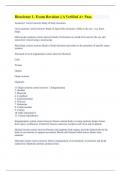
-
Bioscience 1- Exam Revision || A Verified A+ Pass.
- Exam (elaborations) • 60 pages • 2024
- Available in package deal
-
- £14.69
- + learn more
AnatomyC correct answers Study of body structures Gross anatomy correct answers Study of large body structures visible to the eye—e.g. heart, lungs. Microscopic anatomy correct answers Study of structures too small to be seen by the eye and instead are viewed using a microscope. Physiology correct answers Study of body functions and relates to the operation of specific organ systems. Structural level of organisation correct answers Chemical Cells Tissues Organs Organ sy...

-
Biology all - Aqsa year 9 Questions & 100% Correct Answers
- Exam (elaborations) • 97 pages • 2024
-
- £11.01
- + learn more
2.1 describe the levels of organisation in organisms: organelles, cells, tissues, organs and systems ~~> Tissues are a collection of similar cells all serving a common function. Organs are made up of several kinds of tissues together forming a functioning unit. Systems are several organs forming an organ system. Like the cardiovascular system is made up of the heart, blood and blood vessels. 2.2 describe cell structures, including the nucleus, cytoplasm, cell membrane, cell ...
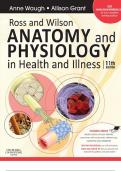
-
Ross and Wilson Anatomy and Physiology in Health and Illness_ With access to Ross & Wilson
- Lecture notes • 1316 pages • 2024
-
- £10.60
- + learn more
Levels of structural complexity Learning outcome After studying this section you should be able to: describe the levels of structural complexity within the body. Within the body are different levels of structural organisation and complexity. The most fundamental level is chemical. Atoms combine to form molecules, of which there are a vast range in the body. The structures, properties and functions of important biological molecules are considered in Chapter 2. Cells are the smallest indep...
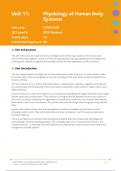
-
Physiology of Human Body Systems
- Exam (elaborations) • 13 pages • 2024
-
- £14.69
- + learn more
1 Know the levels of organisation within the human body Ultrastructure of an animal cell: plasma membrane; cytoplasm; nucleus; nucleolus; endoplasmic reticulum; golgi apparatus; vesicles; lysosomes; ribosomes; mitochondria; centrioles Tissue types: epithelial (glandular, lining, covering), eg salivary gland of digestive tract, endothelial lining of arteries and veins in the cardiovascular system, epithelial lining of lung tissue in the respiratory system; muscular, eg smooth muscle surro...
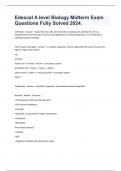
-
Edexcel A level Biology Midterm Exam Questions Fully Solved 2024.
- Exam (elaborations) • 16 pages • 2024
- Available in package deal
-
- £8.15
- + learn more
Cell theory - Answer States that new cells are formed from existing cells and that the cell is a fundamental unit of structure, function and organisation in all living organisms. it is considered a unifying concept in biology Cells, tissues and organs - Answer In complex organisms, cell are organised into tissues, tissues into organs, organs into systems e.g. animal↓ muscle cell → muscle → heart → circulatory system specialised cell → tissue → organ → system xylem vesse...

-
Biol2220 Final Exam QUESTIONS AND CORRECT DETAILED ANSWERS (VERIFIED ANSWERS) |ALREADY GRADED A+
- Exam (elaborations) • 17 pages • 2024
- Available in package deal
-
- £10.60
- + learn more
Biol2220 Final Exam QUESTIONS AND CORRECT DETAILED ANSWERS (VERIFIED ANSWERS) |ALREADY GRADED A+ Homeostasis - Answers - Maintenance of relatively constant conditions in the internal environment Significance of Homeostasis - Answers - Disruption can lead to disease; Body can adapt to mild stressors; Variables that need to remain constant: composition, temperature, volume Positive Feedback Loops - Answers - Positive Feedback: the response of system goes in the same direction as the chang...
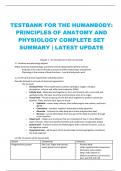
-
TESTBANK FOR THE HUMANBODY: PRINCIPLES OF ANATOMY AND PHYSIOLOGY COMPLETE SET SUMMARY | LATEST UPDATE
- Exam (elaborations) • 139 pages • 2023
-
- £9.79
- + learn more
TESTBANK FOR THE HUMANBODY: PRINCIPLES OF ANATOMY AND PHYSIOLOGY COMPLETE SET SUMMARY | LATEST UPDATE Chapter 1 – An introduction to the human body 1.1 Anatomy and physiology defined Define anatomy and physiology, and name severalsubspecialties of these sciences - Anatomy is the science of body structures and the relationships among them - Physiology is the science of body functions – how the body parts work 1.2 Levels of structural organisation and body systems Describe the bo...

-
Bacterial colonization || All Answers Are Correct 100%.
- Exam (elaborations) • 11 pages • 2024
-
- £8.81
- + learn more
fimbriae/pili, afimbrial adhesins correct answers mechanisms of adhesion to host surfaces adhesins at tip that bind to specific glycoproteins/glycolipids on host cell membranes, long major filament that can extend beyond the capsule correct answers main features of pili/fimbriae molecules embedded in bacterial membranes, bind to glycoproteins or glycolipids on host membranes or can bind ECM such as fibronectin correct answers main features of afimbrial adhesins tracheal colonization fac...
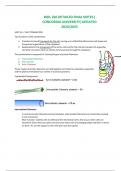
-
BIOL 266 DETAILED FINAL NOTES| CONCORDIA UNIVERSITY|UPDATED 2024/2025
- Exam (elaborations) • 30 pages • 2024
-
- £10.20
- + learn more
BIOL 266 DETAILED FINAL NOTES| CONCORDIA UNIVERSITY|UPDATED 2024/2025 UNIT 9.0 – THE CYTOSKELETON Two functions of the cytoskeleton: 1. Provides structural framework for the cell,serving as a scaffold that determines cell shape and the general organisation of the cytoplasm. 2. Responsible for the movements of the entire cells and for the internal transport of organelles and other structures (such as mitotic chromosomes) through the cytoplasm. The cytoskeleton is composed of 3 principa...

-
GCSE Biology AQA (Organisation) Graded A
- Exam (elaborations) • 12 pages • 2024
- Available in package deal
-
- £8.56
- + learn more
GCSE Biology AQA (Organisation) Graded A Specialised cells As an organism develops, cells differentiate to form different types of cells. As a cell differentiates: - it may change shape - different sub-cellular structures develop to let it to carry out a specific function. Include cells such as sperm, nerve and muscle cells. Sperm cell Tail: to propel the sperm to fertilise the egg. Mitochondria: sperm have many of these cell components, which are the major site of respiration, to ...

£5.50 for your revision notes multiplied by 100 fellow students... Do the math: that's a lot of money! Don't be a thief of your own wallet and start uploading yours now. Discover all about earning on Stuvia


